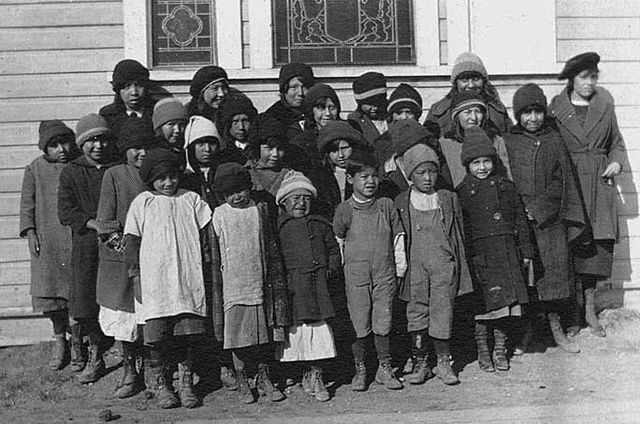by JANET BROWNING
 A group of children from St. Paul’s School in Cardston, Alberta: For over a century, the Canadian state sponsored a program in which indigenous children were taken from their families and sent to church-run residential schools, where they were abused and humiliated.
A group of children from St. Paul’s School in Cardston, Alberta: For over a century, the Canadian state sponsored a program in which indigenous children were taken from their families and sent to church-run residential schools, where they were abused and humiliated.
Clearing the Plains: Disease, Politics of Starvation, and the Loss of Aboriginal Life by James Daschuk
James Daschuk, an academic at the University of Regina, has produced a study on the health of Canada’s indigenous people up to and including the nineteenth century. Clearing the Plains provides a devastating indictment of Canadian capitalism’s subjugation and decimation of the Native Indian (First Nations) population on the country’s western plains—the modern-day Prairie provinces of Manitoba, Saskatchewan, and Alberta.
Daschuk’s study, which is based on extensive archival research, is aimed at identifying the roots of the stark health disparity between the current-day indigenous and non-indigenous populations of western Canada. At the beginning of Clearing the Plains, Daschuk notes that on average, indigenous Canadians can expect to die between five and eight years earlier than other Canadians. He sets out to confirm that the deliberate economic and cultural marginalization of indigenous people by the Canadian capitalist state is the primary factor impeding improved health outcomes for First Nations people.
The book divides the history of indigenous people’s health into two periods:
1. Before 1869, when the spread of “virgin soil epidemics,” such as tuberculosis, smallpox, whooping cough and scarlet fever, constituted a tragic, unforeseen, but largely organic, change driven by the expansion of trade and increased contact with Europeans; and
2. After December 1869, when, with the purchase of the “Hudson Bay lands” by the recently established Dominion of Canada, the Canadian bourgeoisie and its state mounted a concerted drive to impose capitalist relations based on private property on Canada’s Great Plains. This led to a systematic policy of marginalizing the indigenous population and forcing them off their land, through violence, chicanery, and the deliberate withholding of food—that is, starvation.
Daschuk’s research reveals that in the first period of colonization, indigenous people on the Plains generally enjoyed good health. Indeed, they were observed to be larger than Europeans at the time of initial contact. This was no doubt due to their high protein diet, which was mainly based on the consumption of bison.
European explorers and traders brought smallpox and measles. These and other infectious diseases had a devastating impact because the Native population had no previous exposure to them, hence the term “virgin soil diseases.” As trade spread across the continent, indigenous communities were ravaged by disease, badly disrupting their patterns of life, resulting in food shortages, weakened immune systems, and still greater depopulation.
Daschuk spends the first five chapters of his work dealing with the historical period from the early seventeenth to the mid-nineteenth centuries, including the fur wars that commenced in the 1780s, and the subsequent period of the Hudson Bay Company’s monopoly over modern-day Western Canada. The remaining four chapters, upon which this review will concentrate, deal with the period following the 1867 merger of the largest British North American colonies into the Dominion of Canada.
The decline of the fur trade and the relentless expansion of capitalism in the St. Lawrence Valley-Great Lakes region buoyed by Britain’s need for foodstuffs, wood and other resources products and by the transfer of impoverished crofters (tenant-farmers) and artisans from Europe to the “New World” pushed colonial settlement and land appropriation ever deeper into the hunting grounds of the indigenous peoples. As in Australasia, the subjugation and dispossession of the Native peoples of North America arose out of the objective logic of capitalist expansion and the incompatibility of capitalist private property and the exploitation of wage-labour with communal forms of property and social organization.
World Socialist Web Site for more
